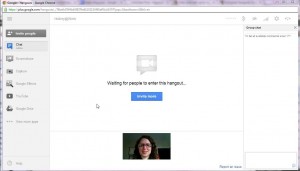Wave of the future or budget cut tsunami? Evaluating technical conference solutions
17 May 2013 – Alima Bucciantini
What do you do when suddenly your panel goes from six people to two? When the U.S. government sequester and tightened institutional budgets mean that your carefully crafted slate of experts can’t make the trip to Ottawa to present in person? This is exactly the situation in which Adina Langer and I found ourselves, mere weeks before this year’s NCPH conference. We had been planning our panel, on the ways that different sites present stories of September 11th, since before the call for proposals last July. We had recruited panelists from the National 9/11 Memorial Museum, the Pentagon Memorial, and the Flight 93 Memorial Park. We had discussed and planned and collaborated.
And then…one by one, our panelists began breaking the bad news. They couldn’t make the trip. What to do? Everyone was still excited to talk about their work and their audiences, but we couldn’t fund them to get to Canada. Adina and I decided to turn to some of the same technology that had allowed us to collaborate on planning the panel in the first place, and see if we could make the show still go on.
In working up a panel proposal, the two of us had used a collaborative Google Document that we both had access to, and as the conference neared, we expanded that into a shared Google Drive folder that the whole panel could see, where we all could share our notes for our presentations, to foster a sense of conversation between everyone. It made sense, then, to try to keep it within the Google family for the actual presentation. With a quick download of a free plugin, everyone could be invited to join a Google Hangout for voice and video chatting.
This worked very well between just Adina and me, and we were even able to share Powerpoint presentations from each other’s screens. Would the day be saved? Well…let’s just say that the trial run with the whole cast was not so smooth. Screens froze, people were kicked out of the Hangout for no apparent reason, and nothing worked as it does on the charming commercials.
We arrived in Ottawa very worried, with copies of everyone’s Powerpoints, and as much of their presentations as possible. We booked a conference call through Adina’s cell phone as backup. Would this be a disaster?
But then, a conference miracle. Everything, more or less, worked. Yes, there were moments of hesitation, where we feared we had lost people to the depths of the internet. Yes, we had to ban people from live-tweeting the panel to reserve bandwidth for the Hangout. But it worked the best it had at any point. It was not perfect. But the NCPH audience got the benefit of our panelists talking on their subjects, even in the face of budget cuts. Our panelists were able to see and hear the audience, and take some questions. The two of us who were able to make it to Ottawa were joined virtually by the full complement of other panelists. It was definitely better than what we thought might happen when it first became clear only Adina and I would make it in person.
So given that budgets are tight all over, and this situation is likely to happen again to other panel organizers, what went right and what went wrong?
I would have preferred a format that allowed more conversation to happen organically among members of the panel, and between panelists and the audience. As it was, the technology hindered much of that, and created artificial barriers to communication. I am not sure there is a free solution to that, however. Google Hangout seems to be, at this moment, the only free, multi-person video-chat platform. It does work better with fewer numbers of people. The best ways to enhance the experience are to have no other programs running on the computer at the time, have a wired, rather than wireless, connection, and use a microphone or headset to minimize background noise.
We found that having panelists use Screenshare to run their own Powerpoints was too much for the Hangout to sustain, so Adina and I had to work the Powerpoint from Ottawa, while panelists spoke. This, understandably, had its awkward moments. It also meant that the panelists could not be seen as they spoke. Having two projector screens would have been nice to help with this problem.
We would have benefited from higher bandwidth in the conference center, so that panel attendees could have continued tweeting, blogging, and notetaking as they listened. I think as conferences continue to be live-blogged, bandwidth and other tech amenities will increasingly be upgraded.
All in all, this experiment in far-flung panel presenting worked better than I feared it would, though less perfectly than I perhaps had been led to expect by a world in which every problem is presented as having a high-tech solution. It would have been preferable to have all of our panelists on site, as the “conferring” part of the “conference” was hindered, and only a basic level of presenting was possible.
The virtual panel worked for us, to solve a problem that emerged at the last minute. I do worry though about this becoming the wave of the future, as travel budgets tighten perhaps permanently. If it becomes only the representatives of the well-endowed universities that can afford to be physically present, while NPS or other government and non-profit staff are confined to their computer screens in the digital conference, it might create separate experiences that cannot be easily bridged by technology, however advanced the interface. Our Google Hangout meant that we did not hang out at the Scone Witch with any of our 9/11 panelist colleagues, and that was a real shame, for them and for us.
~ Alima Bucciantini, Appalachian State University




